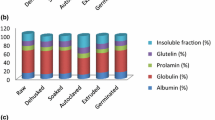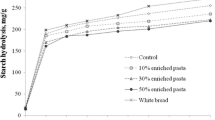Abstract
In order to study the effects of main technological pretreatments practised for preparing Egyptian faba bean products, i.e. decortication as well as soaking and germination followed by dehulling on the nutritional value, series of experiments were carried out. Such pretreatments had a significant effect on the changes in the chemical composition of faba beans. The proportion of the removed hulls reached generally about 14%. Data revealed also pronounced improvements on the nutritive value as a result of all studied pretreatments, especially germination being the most effective. Chemical scoring of all determined essential amino acids was >60, except methionine and cystine showed the lowest score (<20). Germinated seeds had the highest chemical score for the restricting amino acids beside the lowest GDR value [Grams consumed of product to cover the daily requirements for adult man in protein (63 g) and in energy (2900 kcal)]. All pretreatments caused a significant decrease in the antinutritional factors, especially soaking followed by dehulling, whereas decortication led to a significant increase in phytic acid content.
Similar content being viewed by others
References
FAO (1982) FAO 1981 Production year book, FAO United Nations, Rome, Italy.
Jamalian J (1978) Favism — inducing toxins in broad beans (Vicia faba): Determination of vicine content and investigation of other non-protein nitrogen compounds in different broad bean cultivars. J Sci Food Agric 29: 136–141.
Deshpande SS, Sathe SK, Salunkhe DK, Cornforth DP (1982) Effects of dehulling on phytic acid, polyphenols and enzyme inhibitors of dry beans (Phaseolus vulgaris, L.). J Food Sci 47: 1846–1850.
Association of Official Analytical Chemists (1980). Official methods of analysis. AOAC, Washington, DC, USA.
Bhatty RS (1973) Extraction of non-protein nitrogen from oil seed meal with different solvents. Cereal Chem 50: 329–336.
Murray ED, Myers CD, Barker LD, Maurice TJ (1981) Functional attributes of proteins: A non-covalent approach to processing and utilizing plant proteins In: Utilization of protein resources (Stanley DW, Murray ED and Less DH (eds), Food and Nutrition Inc., Westport, CNO b 880: 158–176.
Moore S, Spachman DH, Steins W (1958) Chromatography of amino acids on sulphonated polystyrene resins. Anal Chem 30: 1185–1190.
Block RJ, Durrum EL, Zueig G (1958) A manual of paper chromatography and paper electrophoresis. New York: Academic Press.
Whitney EN, Hamilton EMN, Rolfes SR (1990) Understanding nutrition, 5th ed. St. Paul, New York, Los Angeles, San Francisco, West Publishing Company.
Chavan JK, Heigaard J (1981) Detection and partial characterization of subtilisin inhibitors in legume seeds by isoelectric focusing. J Sci Food Agric 32: 857.
Wheeler EI, Ferrel RE (1971) A method for phytic acid determination in wheat and wheat fractions. Cereal Chemistry 48: 312–315.
Snedecor GW, Cochran WG (1967) Statistical Methods. Iowa State Univ, Ames, Io, USA 341.
Kaldy MS (1978) Amino acid composition and protein quality of two faba bean cultivars. Can Inst Food Sci Technol J 11: 97–98.
Hsu D, Leung HK, Finney PL, Morad MM (1980) Effect of germination on nutritive value and baking properties of dry peas, lentils and faba beans. J Food Sci 45: 87–92.
Abd El-Aal MH, Hamza MA, Khalil MKM (1985) Tannins in faba beans (Vicia faba L.): Effect of decortication, steeping, germination and cooking methods. Communications in Science & Development Research, Alexandria, Egypt 11 (107): 172–183.
Panda NC, Sahu BK, Mohapatra HC (1979) Indian Vet J 56: 1038–1043.
Udayasekhara Rao P, Deosthale YG (1982) J Sci Food Agric 33: 1013–1016.
Tabekhia MM, Luh BS (1980) Research note: Effect of germination, cooking and canning on phosphorus and phytate retention in dry beans, J Food Sci 45: 406–408.
Author information
Authors and Affiliations
Rights and permissions
About this article
Cite this article
Bakr, A.A. Effect of Egyptian cooking methods of faba beans on its nutritive value, dietary protein utilization and iron deficiency anemia 1. The role of main technological pretreatments. Plant Food Hum Nutr 49, 83–92 (1996). https://doi.org/10.1007/BF01092525
Received:
Accepted:
Issue Date:
DOI: https://doi.org/10.1007/BF01092525




